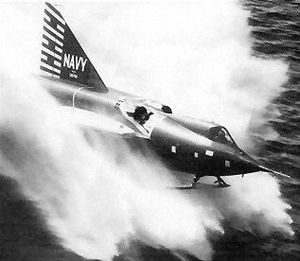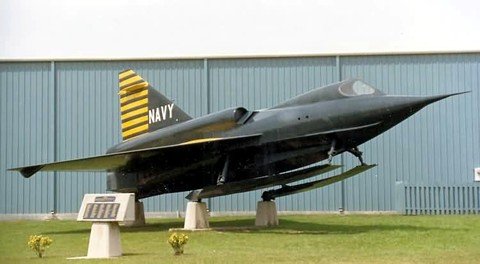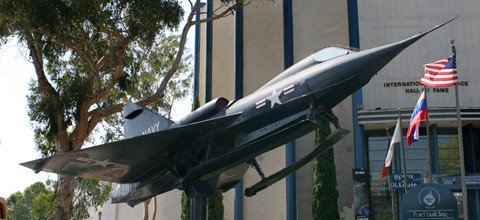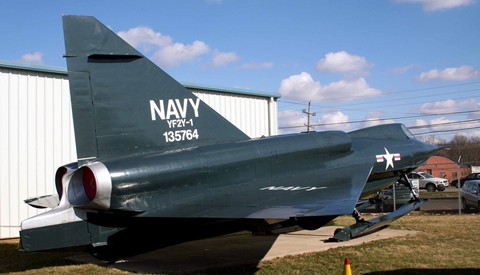|
F2Y Sea DartThe first time I saw a Sea Dart was at NAS Willow Grove. It was situated on the other side of the fence at the base along Rte 611. Are you kidding me? A jet-powered seaplane? BeginningsIn the late 1940s, the US Navy was ordering subsonic jet fighters. The prospect of using supersonic aircraft on carriers brought skepticism with their long takeoff rolls, high speed approaches, and instability. These troublesome factors for a carrier could be avoided if the aircraft could take off and land on water. When the Navy held a contest for a supersonic interceptor aircraft in 1948, Convair responded with the Sea Dart design. Convair received an order for two prototypes on January 19, 1951. The prototypes were assigned XF2Y-1 (Bureau numbers 137634 and 137635). Since the Navy was confident, twelve production aircraft were ordered on August 28, 1952, before a prototype had even flown. Though the plan was to arm the military aircraft with four 20mm cannons and folding-fin rockets, not one was ever fitted with armament. Four aircraft from this order were deemed as service test vehicles and designated YF2Y-1. Another eight aircraft were ordered bringing the total to 22: two XF2Y-1 prototypes, four YF2Y-1 service test aircraft, and sixteen F2Y-1 production Sea Darts. DesignThe aircraft was to be a delta-winged fighter with a watertight hull and twin retractable hydro-skis for takeoff and landing. When stationary or moving slowly in the water, the plane floated with the trailing edge of the wings touching the water. The skis were not extended until the aircraft reached about 10 mph during its takeoff run. Power was to be a pair of afterburning Westinghouse XJ46-WE-02 turbojets, fed from intakes mounted high above the wings to avoid ingesting spray. As these engines were not ready for the prototypes, twin Westinghouse J34-WE-32 engines of just over half the power were installed. It Flies
Following a series of taxi trials in December 1952 through early 1953, the official maiden flight of the first prototype (137634) Sea Dart took place on April 9, 1953. See Photo to the right courtesy of the US Navy. The key word here is ‘official’ since the aircraft inadvertently became airborne during one of the taxi trials. As expected, the underpowered engines made the fighter sluggish, and the hydro-skis were not as successful as hoped. They created violent vibration during takeoff and landing, despite the shock-absorbing oleo legs they were extended on. Work on the skis and oleo legs improved this situation somewhat, but they could not cure the sluggish performance. The order for the second prototype (137635) was canceled and the first of the YF2Y-1 (135762) service test aircraft with the powerful J46 engines was put through its paces. On August 3, 1954, Charles Richbourg took this aircraft into a shallow dive and broke through the sound barrier. The Y2FY-1 became the only seaplane to go supersonic. Sadly, Richbourg was killed while demonstrating 135762 over San Diego Bay, as Navy officials and the press watched in horror. The aircraft disintegrated. As a result of the tragedy and the design problems with the Sea Dart, the Navy canceled all the production F2Y-1s, but kept on developing the XF2Y-1 prototype and the three remaining YF2Y-1 service test aircraft. Only the lone prototype and the second service test aircraft would ever fly. The Navy’s interest in jet seaplane fighters waned as supersonic carrier-based fighter designs proved worthy and became the norm. Further DevelopmentsThe lone prototype (137634) was fitted with an experimental single-ski configuration which proved to be rather more successful, while the second service test aircraft trialed (unsuccessfully) a new twin-ski design. Testing with several other experimental ski configurations continued with the prototype through 1957. This Sea Dart is now in storage at the Paul Garber Restoration Facility of the Smithsonian Institute in Suitland, MD, awaiting restoration. In the 1950s, the US Navy considered the internal arrangements of a submarine that would carry three of these aircraft stored in pressure chambers that would not protrude from the hull. They would be raised by a portside elevator just aft of the conning tower and set to take off on their own on a smooth sea but catapulted aft in a higher sea. The program only reached the talking stage, for two problems were not addressed: the hole for the elevator would have seriously weakened the hull and the load of a laden elevator would also be difficult to transmit to the hull structure. SurvivorsThe three surviving YF2Y-1s are all on display at various aviation museums in the US as seen below.
Convair YF2Y-1 Sea Dart (135765) on display at the Florida Air Museum, Lakeland, FL. Photo Courtesy Jorma Kivilahti, www.1000aircraftphotos.com.
Convair YF2Y-1 Sea Dart (135763) perched outside the main entrance of the San Diego Air and Space Museum, CA.
Two photos of YF2Y-1 Sea Dart (135764) on display at the Harold F. Pitcairn Wings of Freedom Aviation Museum, just outside NAS Willow Grove, PA. The museum is operated by the Delaware Valley Historical Aircraft Association. Photos by Horace Sagnor. Navigation IndexReturn to the top of this Sea Dart page
|




